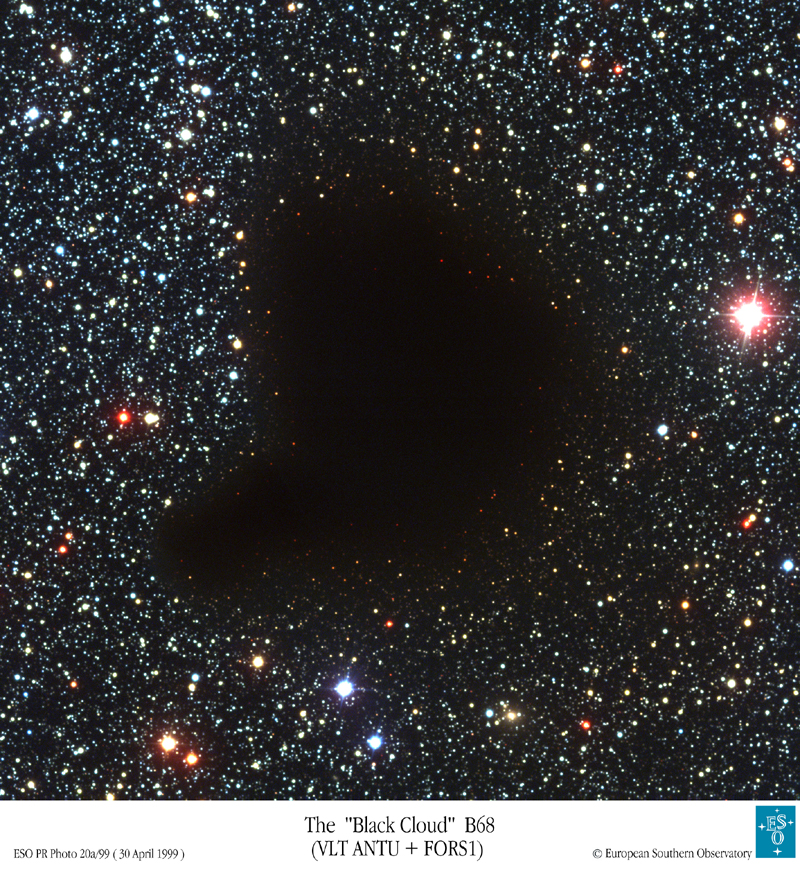
 Copyright © Michael Richmond.
This work is licensed under a Creative Commons License.
Copyright © Michael Richmond.
This work is licensed under a Creative Commons License.
You've heard that space is big (really big). The distance between even nearby stars is immense: thousands of millions of millions of kilometers. When we look up in the night sky, it seems that the space between the stars is a giant dark void. But -- is it really empty?
As soon as astronomers trained telescopes on the Milky Way, they found a number of "dark patches" in which the stellar density falls far below the local average.

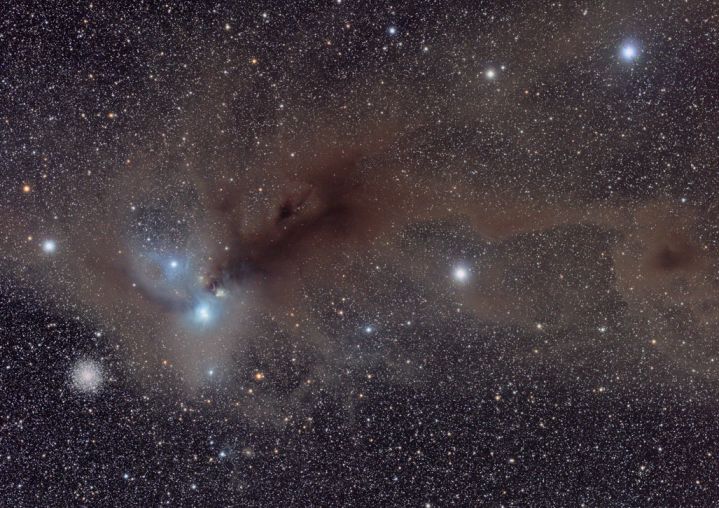
Taken from
APOD.
Credit and
Copyright:
Loke Kun Tan
(StarryScapes)
The nature of these patches was a mystery; some claimed they were caused by clouds in space, blocking the light from stars behind them. Othe astronomers interpreted the dark areas to be giant "holes" or "tunnels" in the distribution of stars, through which we could see to much greater distances, beyond the Milky Way. Neither camp was able to provide convincing evidence that its view was the right one.
In 1930, Robert Trumpler finally came up with the crucial experiment. Using telescopes at the Lick Observatory, he investigated a set of about 100 open star clusters: loose groups of relatively young stars which travel through space together. He measured several quantities for each cluster:
He then used two different methods to determine the distance to each cluster, one based on brightness and the other based on size. As an analogy, consider an observer looking at identical twin brothers.

First, he divided the clusters into groups, based on the number of stars in each and the degree of central concentration. He assumed that clusters within each group, having roughly the same number and distribution of stars, should be about the same physical size. Then, using the apparent size of each cluster, he was able to calculate a relative distance: clusters which appeared small would be far away, and those which appeared large would be close the Sun. He called this estimate the Diameter Distance.
By analogy, an observer can judge the relative distance of the twins by looking at their apparent sizes.
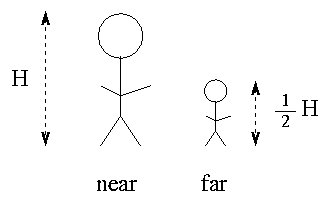
Next, he applied the inverse square law to individual stars: the spectral class of a star yielded its absolute magnitude (and, hence, intrinsic brightness), and his own photographic plates provided each star's apparent magnitude (hence, apparent brightness). Assuming that light travelled freely through space, he calculated the distance to each star, and averaged them to find the distance to each cluster. He labelled this estimate the Photometric Distance.
In our analogy, the observer might use the apparent brightness of identical torches held by the twins to determine their relative distance.
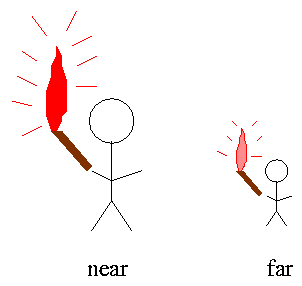
Now, the crucial step: Trumpler compared the two estimates of distance to each cluster. He made a diagram in which he plotted the photometric distance to each cluster on the X-axis, and the diameter distance on the Y-axis. If light travelled freely through space, unaffected by any material, then the two different distance estimates should yield the same result, and all the points should lie along a straight line of slope 1.
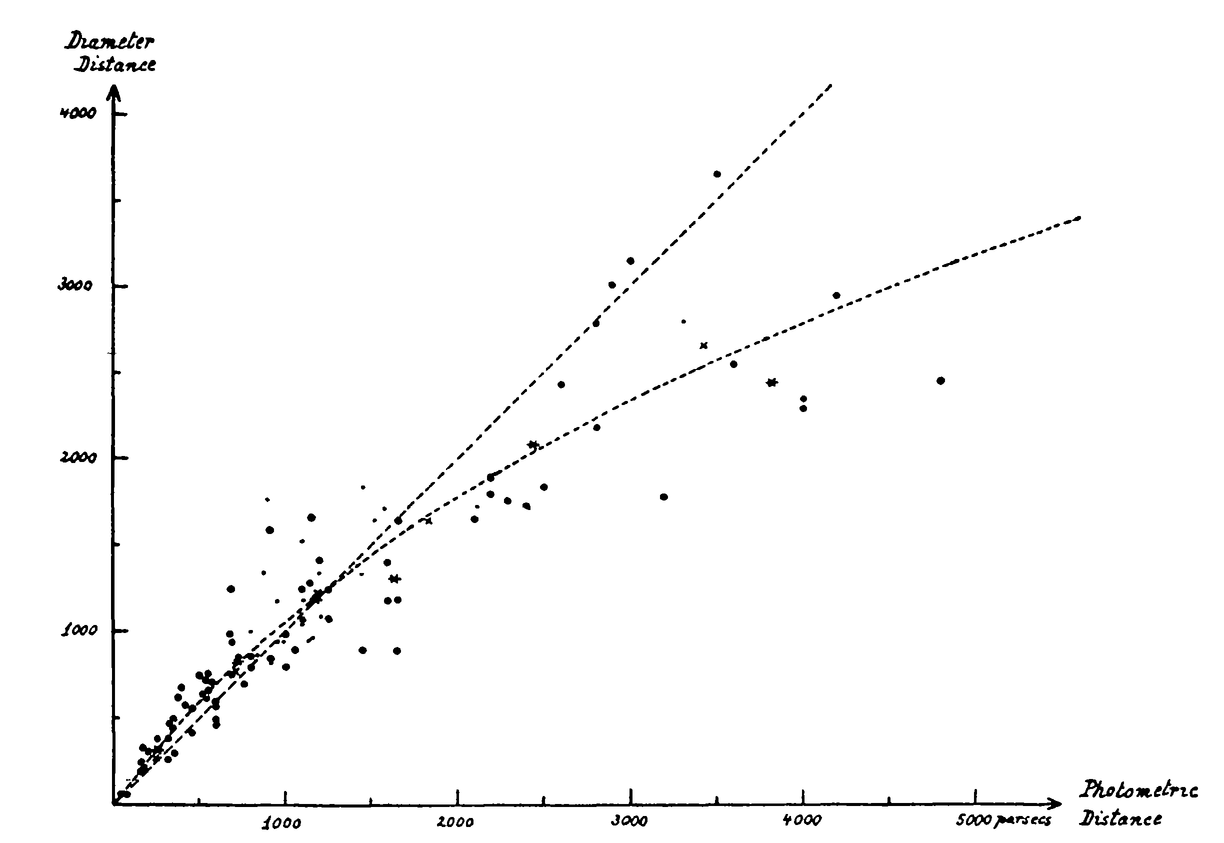
But Trumpler saw immediately that most of the clusters showed larger photometric distances than one would expect from their diameter distances. In other words, the stars in most of the clusters appeared FAINTER than expected. Moreover, the difference between the two distance measures appeared to increase with distance.
Trumpler considered two explanations for this effect.
Trumpler concluded that the second explanation was correct. The space between stars was not empty, but full of a material which affects light passing through it: tiny particles of dust.
Anyone who has watched a sunset is familiar with the effect of air molecules on sunlight: the light becomes progressively dimmer as the Sun sinks towards the horizon ... but it also grows redder.

Taken from
APOD .
Credit and Copyright: Murray Alexander
Why does the color change?

The answer is that when the Sun lies near the horizon, rays of light must pass through a thick layer of air to reach our eyes. Each time a light ray passes close to an air molecule, there is a chance that it will be scattered: absorbed briefly by the molecule, and then re-emitted in a random direction. Only those rays of light which avoid all the air molecules reach our eyes. It turns out that the wavelength of light affects the probability that it will interact with a particle when it passes nearby: short wavelength (blue) light is much more likely to be scattered than long wavelength (red) light. The Sun emits light of a mix of wavelengths, all of which are increasingly scattered as the Sun sets: that's why the sky grows dim. In addition, blue light rays are scattered more strongly than red ones, and so the fraction which reaches our eyes becomes more and more red. The atmosphere causes both extinction and reddening.
The air molecules which make up the Earth's atmosphere consist of only two or three atoms. They are less than a nanometer in size, much smaller than the wavelength of visible light (which ranges from about 400 to about 800 nanometers). When light passes through particles much smaller than its own wavelength, it obeys the Rayleigh scattering law:

Q: How much more likely is a
blue photon to be scattered
than a red photon?
When we observe stars which lie behind clouds of dust, however, we find a different relationship: blue light is only about twice as likely to be scattered as red light:

This much weaker dependence of scattering on wavelength tells us something about the dust particles: they must not be tiny compared to the wavelength of visible light. Instead, this relationship indicates that the dust particles must be about the same size as a wavelength of visible light: a few hundred to a few thousand nanometers in diameter. In order to be so large, dust particles must be made of millions to billions of atoms.
There is one more factor which controls the scattering of light by dust particles. Light rays can be described as oscillating packets of electric and magnetic field. The electric field of a photon points in some particular direction as it flies through space. When a light ray encounters a spherical dust grain, it is equally likely to be scattered, no matter which way its electric field is pointing. But if the dust grain is asymmetric -- squashed or elongated or lopsided -- the probability of interaction depends on the orientation of the light ray's electric field: if the grain's long axis lies parallel to the electric field, it is more likely to scatter the light ray. If a cloud contains many asymmetric dust grains, and a magnetic field strong enough to align most of the grains in the same direction, then light passing through the cloud will be polarized: although rays with an equal mixture of all electric field orientations enter the cloud, those which pass through it will preferentially have electric fields perpendicular to the dust grains.
The amount of reddening we observe when light passes through a cloud of dust tells us how large a typical dust grain is. But size is only one characteristic; are there any observations we can make to learn about a grain's shape, or its chemical composition? The answer is "yes" in each case.
Astronomers use instruments called polarimeters to measure the orientation of electric fields in the light rays collected by their telescopes. Ordinary starlight has electric fields which point in all directions equally: unpolarized light. But when we look at stars which lie behind clouds of dust, we sometimes detect a preferred direction in the light's electric field. This means that at least some clouds must have asymmetric dust grains to polarize the light which passes through them. The degree of polarization in a cloud depends on both the the fraction of grains which are nonspherical, and the amount by which they are squashed. Typical dust grains turn out to be like potatoes: some are nearly round, others elongated by moderate amounts.
Another way to analyze starlight is to pass it through a spectrograph, which separates photons of different wavelengths. When we examine the spectrum of an ordinary star, we see a large number of narrow absorption lines due to the gas in the outermost layer of the star's atmosphere. The spectrum of starlight which has passed through interstellar clouds shows additional absorption features.
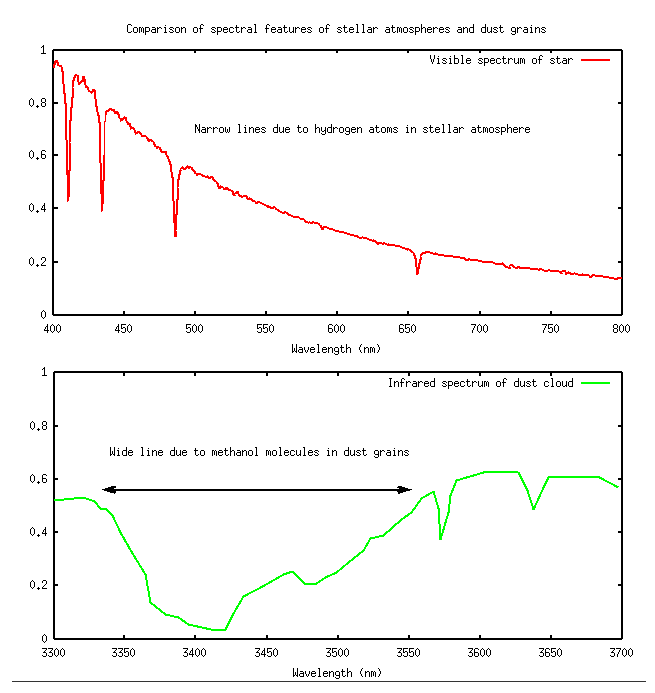
In the near infrared, spectra of stars seen through dusty clouds show a number of very wide absorption lines. The width is a clue to their origin: molecules can interact with light in wide bands around particular wavelengths, unlike single atoms. Scientists have matched these absorption features to several different sorts of substances:
Some clouds appear to contain mostly carbonaceous grains, whereas others are mostly silicate-rich grains; it depends on the chemistry of the star(s) which ejected material into the cloud long ago.
The Earth runs into such particles every day as it moves around the Sun. Our atmosphere acts like a giant broom, sweeping up a giant pile of dust. If one flies an airplane high into the atmosphere

one can collect particles before they interact too much with earthly materials. Scientists have found a number of dust grains which must be of extraterrestrial origin (based on their chemical composition). In the pictures below, the white scale bar is 1 micron = 10^(-6) meters in length.
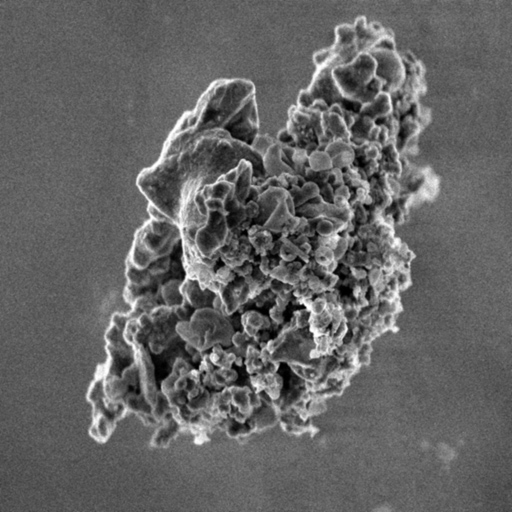
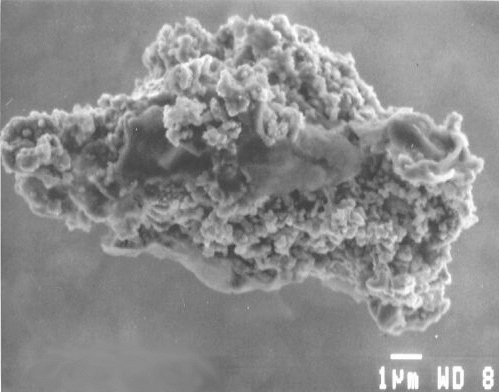
The grains appear to be loose conglomerations of smaller specks of material, which stuck together after bumping into each other in the depths of space.
Dust grains, like all other components of the interstellar medium, go through cycles of creation, evolution, and destruction. Let's look at each step in the process.
Grains are born from material ejected from stars: in the thick, cool, slow winds of red giants, or the blobs of gas shot outwards into space when a supernova explodes. As gaseous ejecta expands away from its source, it cools. Refractory elements, such as aluminum, iron, and silicon, condense into solid form when the gas is still warm, at temperatures over a thousand degrees Kelvin. Compounds of these elements form the cores of dust grains. As the gas continues to cool, lighter elements such as carbon, oxygen, and hydrogen, gradually adhere to the cores and build up an ice-rich mantle. The entire process takes roughly a million years, but goes more quickly in dense, cool regions.
As the ejecta from a star continues to expand, it gradually thins out and becomes transparent to light from other stars. When dust grains are exposed to visible and ultraviolet light, their surfaces undergo chemical reactions. The simple molecules of water, carbon monoxide, methane, etc., are broken apart, and their atoms recombine to form larger organic compounds: acetone and ethanol, for example. Some of these molecules then evaporate from the surface of the grain and return to a gaseous state, where we can detect them via their emission of radio and millimeter waves. You may have read articles describing the discovery of enormous quantities of alcohol in space; that alcohol was created on the surfaces of interstellar dust grains. In fact, the surfaces of dust grains are like little factories, bringing together atoms that might otherwise rarely meet and catalyzing their reactions.
If a grain is exposured to too much radiation, it may evaporate completely. Ices will leave the surface of the grain as it warms up, at temperatures ranging from 20 K for methane to 100 K for water. The silicate core of a dust grain remains intact at these temperatures, but may be destroyed if the grain collides with other particles moving at high speeds. Shock waves in the hot interstellar medium, produced by supernova explosions, can smash grains together violently enough to distingrate them completely. Studies of the cloud motion and interaction suggest that icy grains and mantles remain intact only for a few million years at most; the tougher graphite and silicate grains may last for several hundred million years until they run into a shock wave.
 Copyright © Michael Richmond.
This work is licensed under a Creative Commons License.
Copyright © Michael Richmond.
This work is licensed under a Creative Commons License.